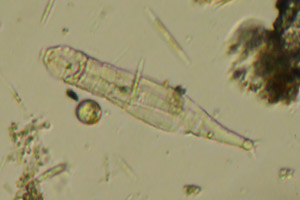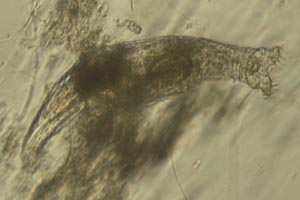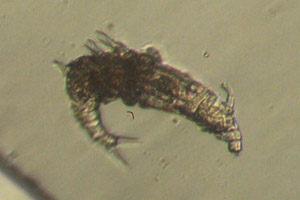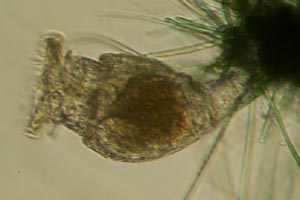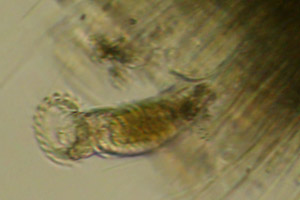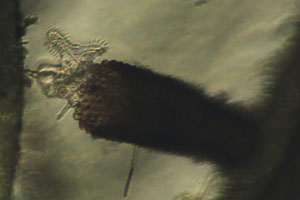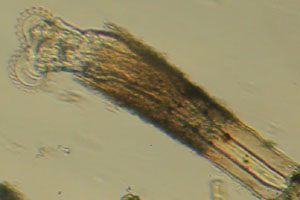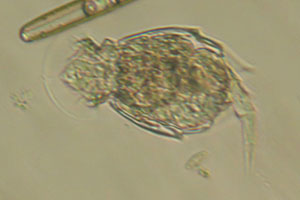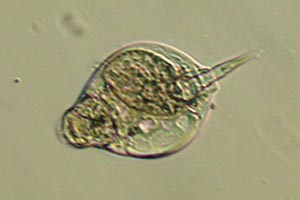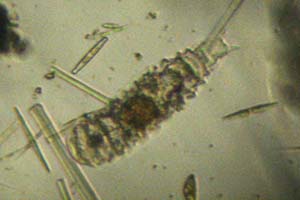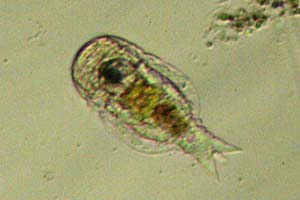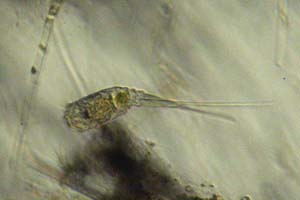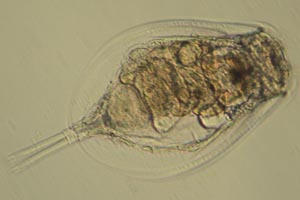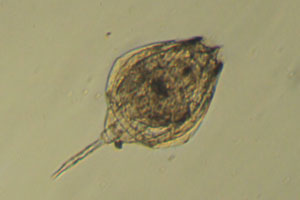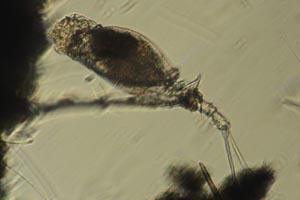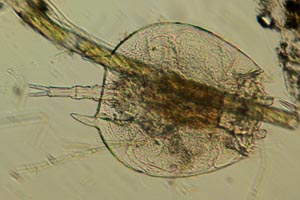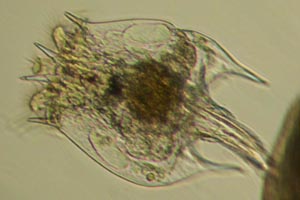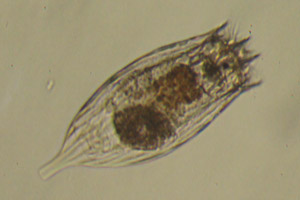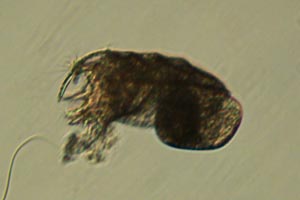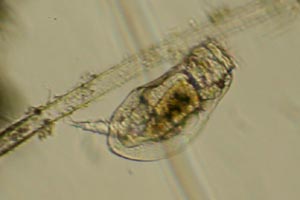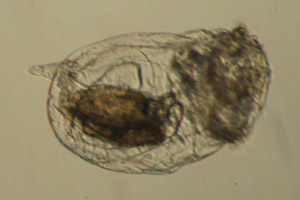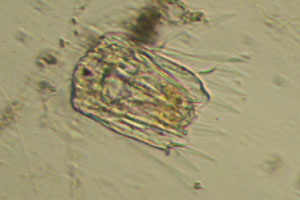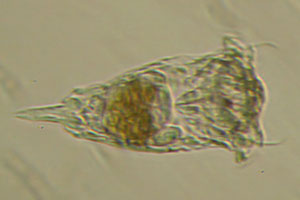Kingdom Animalia, Phylum Gnathifera
Gnathifera occur in water, sediments, and as parasites of other animals. Free-living kinds have characteristic jaws in the throat, and most are less than 1 mm long, using cilia to move or collect food. Rotifers are by far the most common of these, including all but a few kinds from marine sands.
The cilia in rotifers form a corona or crown around the mouth, which ranges from a simple field to complex lobes and bristles. In most the body has a posterior foot, which usually has two or more toes and adhesive glands, used to form temporary or permanent attachments. Some also have sensory antennae and simple eyes.
Reproduction takes place by laying eggs or sometimes live birth. Most individuals are female and parthenogenetic, i.e. have offspring without mating. Normally males are smaller and reduced, and only occur under certain conditions, so are rarely encountered.
Bdelloids are exclusively female with paired ovaries. They are worm-like and contractile, and variously move by swimming or by alternately stepping with their head and foot. Most have a retractable corona divided into two parts, which look like spinning wheels when active, and two spurs just above the toes.
Adineta
Greek a-, without, dinētos, whirled around
Angl. AD-i-NEE-ta
Adineta have an oval head with a neck but no wheels. They move by sliding the head along, collecting food with a rake and cilia underneath, instead of the usual steps.
Rotaria
Latin rota, wheel
Angl. roh-TAIR-eea
Rotaria mostly have two eyes on a forward projection, the rostrum, ahead of a dorsal antenna. They are typically long, some kinds extremely so, often with prominent spurs.
Dissotrocha
Greek dissos, double, trochos, wheel
Angl. di-SOT-ro-ka
Dissotrocha have long spurs and the body cuticle is stiff, with ventral folds and often dorsal bumps or spines. Eyes are cerebral when present, set behind the antenna.
Philodina
Greek philos, friend, dinos, whirling
Angl. FIL-o-DYE-na
Philodina are more or less pin-shaped with wheels wider than the neck. Most again have cerebral eyes but only smaller spurs and a thin, relatively smooth cuticle.
In monogononts females have a single ovary. They come in a great variety of forms, divided into two main groups. Gnesiotrocha usually have a long foot with no toes, though it is occasionally lost, and many live attached or in colonies. Most have a lobed corona and their jaws are adapted for pounding or cutting.
Testudinella
Latin testudo, turtle, -ella, dimn.
Angl. tes-TOO-di-NEL-a
Testudinella are flat and nearly circular in outline, except for the head, which has two lobes and can be retracted. There is a small ventral foot with cilia, remaining unattached.
Ptygura
Greek ptychē or ptygma, fold, oura, tail
Angl. ti-GYOOR-a
Ptygura have a nearly circular or oval corona without lobes. They usually live in gelatinous cases, in some covered with debris, found most often on aquatic plants and algae.
Floscularia
Latin flos, flower, -culus, dimn.
Angl. FLOS-kyu-LAIR-eea
Floscularia have a corona with four lobes. Some live in gelatinous tubes but most make them from collected material, rolled into pellets and placed into a regular array.
Limnias
Greek limnē, pond
Angl. LIM-neeas
Limnias are sessile with a corona divided into two ciliate lobes. They live inside hardened tubes of secreted material, variously smooth or with sculpted rings.
Collotheca
Greek kolla, glue, thēkē, case
Angl. KOL-o-THEE-ka
Collotheca have several knobs or flaps around the mouth, covered in long fine setae which close inward to trap prey. Most are again sessile with clear gelatinous tubes.
Ploima are typically free-swimming rotifers that have either two toes, rarely reduced to one, or sometimes no foot. The jaws are variously adapted for grinding, sucking, or sometimes gripping prey, and in many kinds the cuticle is hardened to form a protective lorica of one or more plates.
Squatinella
Latin squatina, angel shark, -ella, dimn.
Angl. SKWAT-i-NEL-a
Squatinella are easily recognized by their large head shield, which looks like a halo from above. They have deep bodies with a long foot and often spines.
Colurella
Greek kolouros, truncated
Angl. KOL-yu-REL-a
Colurella are flattened side-to-side with a ventral notch for the foot. The lorica forms a small shield over the head, with a hook that helps them stir up food.
Lepadella
Greek lepas, limpet
Angl. LEP-a-DEL-a
Lepadella also have a ventral notch for the foot, but the lorica is flattened top-to-bottom. The foot itself has 3-4 marked rings, short toes, and serves as a flexible attachment while feeding.
Taphrocampa
Greek taphros, ditch, kampē, caterpillar
Angl. TAF-ro-KAM-pa
Taphrocampa are slender and flexible, with a dorsal eye near the front and short toes at the posterior. The body is divided into marked rings by a series of distinctive grooves.
Notommata
Greek nōton, back, omma, eye
Angl. noh-TOM-a-ta
Notommata resemble the above but lack the grooves. They are similar to several other genera, but a few species may be recognized by a spine-like tail from between the toes.
Monommata
Greek monos, one, omma, eye
Angl. mo-NOM-a-ta
Monommata are another kind with one eye and no lorica. The toes are well-developed, with the left normally slightly shorter than the right, but both longer than the body.
Trichocerca
Greek thrix, hair, kerkos, tail
Angl. TRIK-o-SER-ka
Trichocerca have a cylindrical lorica, often with short spines at the front or ridges. The foot is reduced with mismatched toes, in many kinds with one very long and one very short.
Euchlanis
Greek eus, good, chlanis, fine cloak
Angl. YOO-kla-nis
Euchlanis have their lorica separated into a larger dorsal and flat ventral plate. The former curves over the base of the foot, which has 2-3 weakly marked rings and two toes.
Lecane
Greek lekanē, dish
Angl. LEK-a-nee
Lecane have their foot reduced to a flexible base with one or two style-like toes. The lorica is also flattened and separated into dorsal and ventral plates.
Trichotria
Greek thrix, hair, tria, three
Angl. tri-KOH-treea
Trichotria have a thick lorica with ridges on either side. Their foot and toes are long, with a characteristic pair of spines where they meet the body.
Platyias
Greek platys, flat
Angl. pla-TYE-as
Platyias have a flattened lorica with short spines on the front and rear margins. The foot has marked segments and toes, and is attached under the body.
Brachionus
Greek brachiōn, arm
Angl. bra-KYE-o-nus
Brachionus have a flexible foot without marked segments. The body is flattened with marginal spines, but unlike Platyias has an eye and sometimes carries external eggs.
Notholca
Greek nōton, back, aulax or hōlka, furrow
Angl. no-THOL-ka
Notholca have six short anterior spines and sometimes a pointed tail, but no foot, toes, or carried eggs. The lorica is flattened and typically has lengthwise furrows or a keel.
Keratella
Greek keras, horn
Angl. KER-a-TEL-a
Keratella also have no foot or toes, but the lorica is divided into several facets rather than striated. They often have attached eggs and some have one or two posterior spines.
Lophocharis
Greek lophos, crest, charis, grace
Angl. lo-FOK-ar-is
Lophocharis have an oval to rhombus-shaped lorica with a thin raised crest along the back. The foot emerges behind the end, with 3 marked rings and short toes.
Mytilina
Latin mitulus or mytilus, mussel
Angl. MIT-i-LYE-na
Mytilina have a lorica with a dorsal furrow. The front and rear margins often have spines and cover the base of the foot, which is typically short with pointed toes.
Scaridium
Greek skaros, leap, -idion, dimn.
Angl. ska-RID-eeum
Scaridium are long rotifers with a thin cylindrical lorica. The foot and toes are each about the same length as the body, and can act as a spring for sudden movement.
Asplanchnopus
Greek asplagchnos, without innards, pous, foot
Angl. a-SPLANK-no-pus
Asplanchnopus are sack-like rotifers that eat other animals, using their jaws to seize and swallow them whole. The body is hollow and contractile, with a small foot on its underside.
Polyarthra
Greek polys, much or many, arthron, joint
Angl. POL-ee-AR-thra
Polyarthra are set apart by blade-shaped appendages in four groups around the front, used in a rapid jumping motion. There is no foot but some carry attached eggs.
Synchaeta
Greek syn, together, chaitē, long hair
Angl. sing-KEE-ta
Synchaeta have a more or less conical body ending in a short foot and toes. The head has a ciliated projection on either side, with four spines and one eye between them.
